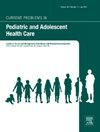Adolescents and cannabis in the 21st century
IF 3.7
4区 医学
Q1 PEDIATRICS
Current Problems in Pediatric and Adolescent Health Care
Pub Date : 2025-03-01
DOI:10.1016/j.cppeds.2025.101754
引用次数: 0
Abstract
The past 30 years in the United States have seen a shift towards increasing decriminalization and legalization of cannabis products. Despite the evolving legal landscape, adolescent cannabis use appears to have remained relatively stable, while use among young adults has increased. Cannabis-related emergency department visits, hospitalizations, and unintentional ingestions, particularly among young children, have all increased, with the availability of higher potency products such as concentrates and edibles likely playing a role. Cannabis intoxication should be suspected in youth presenting with altered mental status, somnolence, anxiety or euphoria, tachycardia, and conjunctival injection. In adolescents presenting with cyclic vomiting, cannabinoid hyperemesis syndrome should be considered. Long-term effects of heavy and frequent cannabis use in adolescents such as cognitive impairment, increased risk of psychosis, and the development of cannabis use disorder remain of particular concern as the tetrahydrocannabinol (THC) content of cannabis products has continued to increase in recent years. Ongoing surveillance to monitor trends in adolescent cannabis use, public education on the health effects of cannabis use in adolescence, and expanding access to substance use and mental health treatment will be crucial in the coming years.
21世纪的青少年和大麻:目前儿科和青少年保健中的问题。
在过去的30年里,美国已经看到了大麻产品越来越非刑事化和合法化的转变。尽管法律环境不断变化,但青少年大麻的使用似乎保持相对稳定,而年轻人的使用有所增加。与大麻有关的急诊就诊、住院治疗和意外摄入,特别是在幼儿中,都在增加,而浓缩物和可食用物等更高效力产品的可用性可能发挥了作用。青少年出现精神状态改变、嗜睡、焦虑或欣快、心动过速和结膜注射时应怀疑大麻中毒。在出现周期性呕吐的青少年中,应考虑大麻素呕吐综合征。青少年大量和频繁使用大麻的长期影响,如认知障碍、精神病风险增加和大麻使用障碍的发展,仍然特别令人关切,因为近年来大麻产品中的四氢大麻酚(THC)含量持续增加。今后几年,为监测青少年使用大麻的趋势而进行的持续监测、关于青少年使用大麻对健康的影响的公共教育以及扩大获得药物使用和心理健康治疗的机会将是至关重要的。
本文章由计算机程序翻译,如有差异,请以英文原文为准。
求助全文
约1分钟内获得全文
求助全文
来源期刊
CiteScore
4.60
自引率
0.00%
发文量
61
审稿时长
5 days
期刊介绍:
Recognized for its probing, comprehensive, and evidence-based reviews, Current Problems in Pediatric and Adolescent Health Care devotes each issue to a timely and practical topic in pediatric medicine, presented by leading authorities in the field. The journal offers readers easily accessible information that enhances professional experience and is pertinent to daily pediatric practice. Each issue''s review article is accompanied by an additional special feature designed to highlight a particular aspect of the topic presented.

 求助内容:
求助内容: 应助结果提醒方式:
应助结果提醒方式:


